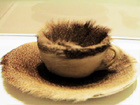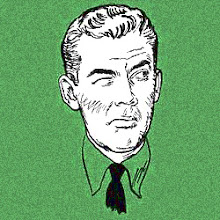 We've seen poet X. J. Kennedy around (at Breadloaf). In '60 he published a satire of modernism, a poem titled "Nude Descending a Staircase" after--of course--the 1912 Marcel Duchamp painting that by '60 had become iconic of the cubist and futurist side of the revolution in art. The Duchamp painting, shown at the 1913 Armory Show, depicted the motion of a nude woman by presenting her as successive superimposed images, similar to stroboscopic motion photography. In 1913 this was scandalous.
We've seen poet X. J. Kennedy around (at Breadloaf). In '60 he published a satire of modernism, a poem titled "Nude Descending a Staircase" after--of course--the 1912 Marcel Duchamp painting that by '60 had become iconic of the cubist and futurist side of the revolution in art. The Duchamp painting, shown at the 1913 Armory Show, depicted the motion of a nude woman by presenting her as successive superimposed images, similar to stroboscopic motion photography. In 1913 this was scandalous. How do we know X. J. Kennedy's poem of 1960 satirizes the Duchamp? Well, would a sincere homage be given in perfectly rhymed ABCB tetrameter quatrains? (Tetrameter with internal rhyme too: "Toe upon toe, a snowing flesh, / A gold of lemon, root and rind") Duchamp's was a form-busting breakthrough, characterized by energy. Kennedy in '60 counters with lines of stasis about the woman's movement: "One-woman waterfall, she wears / Her slow descent like a long cape / And pausing, on the final stair / Collects her motions into shape." In other words, the poem has found her at a certain moment of descent. She collects motions into shape.
There's a condescending pun here: For Kennedy the nude Duchampian woman has "nothing on"... that is to say, nothing on her mind. Empty-headed, stupid or, at best: she is the opposite of the creator of her movement--the object of the modernist subject. And to be sure she's an object, the poet of '60 looks up at her, standing beneath the banister, watching from below as her thighs thresh.
The multiplicity of places from which to observe (all at once - famously, the revolution Duchamp augured here) has become a single p.o.v., and satirically gendered ("we" are gaping at the body, nude upskirt). If Kennedy meant to praise kinetic modernism, then he created a major formal irony in doing so, and completely undoes the aesthetic of the "one-woman waterfall" he sets in stiff rhyming lines.
Toe upon toe, a snowing flesh,
A gold of lemon, root and rind,
She sifts in sunlight down the stairs
With nothing on. Nor on her mind.
We spy beneath the banister
A constant thresh of thigh on thigh--
Her lips imprint the swinging air
That parts to her parts go by.
One-woman waterfall, she wears
Her slow descent like a long cape
And pausing, on the final stair
Collects her motions into shape.

 Is '60 the moment when the end of the end of the Old Left had been reached and the New Left began to emerge? Is it the final ascendancy, in certain scenes at least, of poetic postmodernity? Surely the publication of Donald Allen's The New American Poetry that year suggests this, but then again--once again--we look back on "New" here and see continuity. The rhetoric of the Kennedy-Nixon contest made much less of a dent than everyone (at the time as well as since) claimed, so one wonders why were such great claims made?
Is '60 the moment when the end of the end of the Old Left had been reached and the New Left began to emerge? Is it the final ascendancy, in certain scenes at least, of poetic postmodernity? Surely the publication of Donald Allen's The New American Poetry that year suggests this, but then again--once again--we look back on "New" here and see continuity. The rhetoric of the Kennedy-Nixon contest made much less of a dent than everyone (at the time as well as since) claimed, so one wonders why were such great claims made?  Had we come to expect "1960" to be truly ubiquitously modern in a way that the 1950s really were not--not quite? And what specifically does "modern" mean in the Kennedyesque talk then and now about the torch being passed to a new generation, etc.? The First Lady really meant "modernist" when Camelotians said "modern." What about the others across the new young cultural leadership? I've been surprised by how frequently the
Had we come to expect "1960" to be truly ubiquitously modern in a way that the 1950s really were not--not quite? And what specifically does "modern" mean in the Kennedyesque talk then and now about the torch being passed to a new generation, etc.? The First Lady really meant "modernist" when Camelotians said "modern." What about the others across the new young cultural leadership? I've been surprised by how frequently the  "Beat movement" was covered in 1960 in the mainstream press. I was expecting a fair measure but I've found tonnage. 1960 was the year when the figure of the beat was beginning to find acceptance, although still 80% of these stories are mocking, rebels-without-cause condescension. For anyone whose analysis made an impact nationally, do these antipolitical adolescents count as part of the "new young cultural leadership"? No, but rather than the two being opposites, they fall along a Continuum of the New American. Now that's a change for '60.
"Beat movement" was covered in 1960 in the mainstream press. I was expecting a fair measure but I've found tonnage. 1960 was the year when the figure of the beat was beginning to find acceptance, although still 80% of these stories are mocking, rebels-without-cause condescension. For anyone whose analysis made an impact nationally, do these antipolitical adolescents count as part of the "new young cultural leadership"? No, but rather than the two being opposites, they fall along a Continuum of the New American. Now that's a change for '60.







